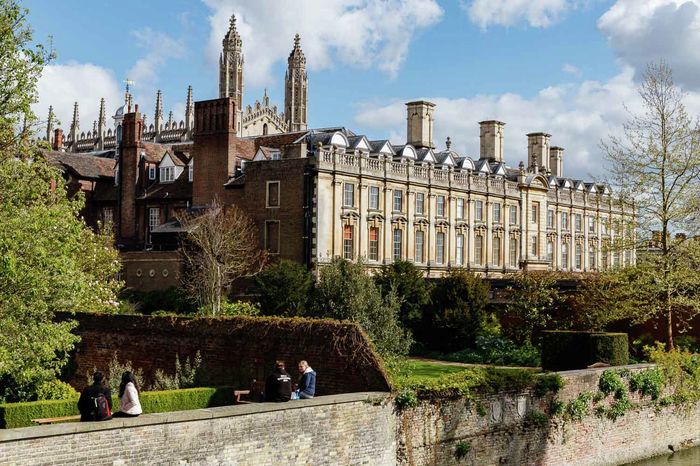The eight charts that explain the University’s 2019-2020 undergraduate admissions data
Varsity’s analysis of the latest admissions data, from record state school intake to the continued decline of EU applicants

Despite modest improvements, the University of Cambridge’s intake continues to see gendered, racial, school-type and regional disparities in applicant’s success rates across colleges and subjects.
The University’s latest admissions statistics, published on Thursday of last week (11/05), refer to applications made for undergraduate courses starting in October 2019 or deferred entry for October 2020.
In this article both 'state' and 'maintained' schools refers to comprehensive and grammar schools, sixth form colleges and further education and tertiary colleges. 'Independent' and 'private' schools refers to institutions outside of this.
State school intake increased to a record 68.7% of total acceptances, up from 65.2% in 2018-2019.
The 3.5% increase is the largest year-on-year jump in state school intake since 2012.
The jump, unlike the somewhat anomalous increase in 2012, follows three admission cycles above a 64% state school intake.
The latest figure means the University is well on it’s way to meeting its target of 69.1% state school acceptances by 2024-25.
However, whilst the new undergraduate admissions statistics highlight a modest improvement in state-school representation, the increase exists within a broader context of ongoing concern around school-type inequality in admission to the University.
Considering 93% of pupils in England are taught in state schools, a figure of 68.7% means that state school students are still vastly under-represented in the University.
In 2018, Cambridge was identified as ‘the most unequal university’ in the UK by the Higher Education Policy Institute, an education think tank.
Cambridge’s acceptance of state school applicants continues to be amongst the lowest in the UK, with 90% of university students on average hailing from state schools across the country.
Admission of BME groups varies dramatically between subjects, ranging from Anglo-Saxon, Norse and Celtic (ASNC) which accepted no people of colour in 2019 to 52.8% representation of BME backgrounds in the first-year medicine cohort.
Aside from ASNC, Geography had the lowest acceptance rate for BME students, with only 7.4% of home students accepted identifying as BME.
18 courses accepted fewer than 3 Black students in 2019 compared to 20 courses in 2019, whilst 11 courses accepted fewer than 3 Asian students and 9 courses accepted fewer than 3 students from Mixed backgrounds in 2019.
The latest admissions statistics show Natural Sciences, the largest subject at Cambridge, admitted only 8 Black students out of a total of 419 home students accepted in 2019, accounting for just 1.3% of admitted students to the course.
Human, Social, and Political Sciences (HSPS) had 14 Black students accepted in 2019, the highest absolute number of Black students accepted amongst all degrees.
Some subjects with similarly sized cohorts varied significantly in the proportion of BME students accepted: Law accepted 53 BME students out of a cohort of 144, while History accepted 31 BME students out of a cohort of 159.
Clear racial disparities also continue to be pervasive in Cambridge admissions; with women of Chinese origin having a success rate close to 30.9% while women of Arab origins were accepted at a rate of 9.8%.
Success rates for Black applicants in 2019 improved on 2018 figures, up to 15.1% from 13% in 2018, continuing a trend towards increasing black success rates in recent years.
Yet, the acceptance rate for Black applicants in 2019 is still below an average success rate of 21.4% for all ethnic groups.
The 2019 admission cycle marked a record number of Black UK undergraduates studying at the University, raising the number of Black students above 3% for the first time in the University’s history.
However, in an open letter early this month, CUSU’s BME Campaign called on the University and Colleges to improve access, stating “that the 3% proportion of black students that make up the undergraduate student body is inadequate."
The letter also implored the University to “develop initiatives” which recognise that “the application process may hinder the success of Black and BME students.”
Among all ethnicities those from Other Black backgrounds continue to have the lowest success rates, with 0 successful applications for males in this category and an overall acceptance rate of 8.3% in 2019 up from 3.7% in 2018.
There also continues to be disparities between white and Black applicants: a 9.1 percentage point difference was found between acceptance rates of Black women and white women - Black and white women held application success rates of 15.9% and 25% respectively. White men also had a success rate 8.1% higher than Black men.
The 2019 admissions cycle saw the continued trend in declining numbers of EU applicants to the University, despite acceptances to EU students remaining relatively constant.
The 2016-2017 academic year experienced a dramatic decline in applicants from the EU, showing the lowest number of absolute EU applicants since 2013 amid post-Brexit uncertainty. Prospective students from the EU declined from 16.1% in 2016 to 13.9% in 2017.
This trend has continued with EU applicants accounting for only 12.5% of total applicants in the 2019 admissions cycle, down from 13.7% in 2018.
EU students applying in the 2019 admission cycle had the UK’s formal exit from the EU, on 31st January 2020, fall during their first year of University.
Despite the University confirming those starting their study at Cambridge in 2019 or 2020 will pay home fees for the duration of their degree, fees remain a significant source of uncertainty for non-UK applicants.
Part of this uncertainty could stem from a lack of clarity which may compound reservations about applying to the UK; only 6 out of 10 EU respondents to the International Student Survey were aware that EU students were eligible for tuition fees at the same rate as domestic students for courses starting in 2019.
Although applicants from the EU have declined the number of prospective students applying from China has risen dramatically, up by 33.0% compared to the 2018 admissions cycle.
Whilst the number of Chinese offer-holders has remained fairly unchanged, the number of Chinese applicants has increased from 890 in 2018 to 1184 in 2019. Chinese prospective students accounted for the largest number of international applicants from one country.
The absolute number of acceptances of Chinese students was greater than the number of places given to students from Northern Ireland, Wales and Scotland combined, although Chinese students had a lower acceptance rate.
Females on average account for 38.9% of offer holders for Science degrees, compared to 62.6% for Arts, Humanities and Social Science subjects.
Only 20.4% of offer holders for Computer Science identified as female in 2019, whilst amongst Mathematics and Engineering this constituted a mere 26.1% of those with offers.
Natural Sciences, Land Economy and Economics, in addition to Maths and Engineering also saw less than half of their offers go to women.
At the other end of the spectrum, Education, Psychological and Behavioural Sciences and Veterinary Medicine saw females account for over 80% of offer holders in 2019.
Nine degrees had over 70% female representation in its offer holders, with 7 of these female-dominated subjects being classified as either an Art, Humanity or Social Sciences.
Cambridge continues to accept applicants primarily from postcode areas with high participation rates in higher education and relatively low levels of deprivation.
The POLAR3 system classifies postcode areas into five groups, based on the participation rates of young people in higher education - quintile 5 (Q5) signifies the most advantaged areas while quintile 1 (Q1) codifies neighbourhoods with the lowest participation rates.
Applicants from POLAR3’s Q5 neighbourhoods account for just under half of the total first-year cohort in 2019, a slight improvement on previous years where students from areas in Q5 represented over half of the incoming freshers.
In comparison, students originating from postcodes in Q1 equalled just under 4.8% of students accepted in 2019.
Success rates for applicants varies greatly depending on their POLAR3’s quintile: Q5 has an acceptance rate of 23.7% compared to Q1 which has a rate of 6.7%.
Only applicants from Q5 have a success rate higher than the average acceptance rate (21.4%).
Applicants from areas within the most deprived 30% of their region, with a success rate of 18.7%, account for only 14.3% of overall home student acceptances in 2019.
The University has identified the prior higher attainment of those in Q5 areas and the extent to which the University draws its intake from London, which contains few Q1 areas, as being compounding factors in the over-representation of students from Q5 areas.
The coronavirus pandemic has raised further concerns about widening participation and access to higher education institutions, including Cambridge.
In a interview with Varsity in May Pro-Vice-Chancellor for Education Graham Virgo also stated he was “really concerned” that the current Covid-19 disruption to education for school and college-age children will disproportionately harm underrepresented groups in the longer term.
In a Joint statement to earlier this month, Colleges identified the difficulties facing students from ‘widening participation’ backgrounds during the pandemic.
Among all undergraduate degrees in the 2019-2020 academic year, Law had the highest proportion of state school offer holders at 85.3% - the ratio of state to independent school offer holders was close to 5.8 to 1.
Veterinary Medicine, Psychological and Behavioural Sciences, Mathematics and History and Politics all also had state school offer holders account for over 80% of total offers given.
In contrast, Classics exhibits the other extreme, having only 27.5% of offer holders from a state school background.
Classics alongside History of Art continue to be the degrees with the lowest state school intake; in 2019, they were the only degrees with offer holders predominantly coming from independent schools.
Classics in 2019 had a ratio of offer-holders from state and independent schools close to 0.38 to 1. For History of Art, the ratio was nearly 0.81 to 1.
On average, Science degrees had a higher proportion of state school offer-holders than the Arts, Humanities and Social Sciences, at 75% and 67.4% respectively.
Excluding mature and postgraduate-only colleges, Gonville and Caius had the lowest state school intake in 2019. 55.4% of the College’s first-year cohort hailed from state schools, compared to 55.9% in 2018.
Robinson and St John’s, which have frequently been amongst the colleges with the lowest proportions of state school students in recent years, had the second and third lowest state school intake respectively.
Robinson, which had the lowest proportion of incoming freshers from a state school background in 2018, 2015 and 2014, accepted 56.3% of its 2019 cohort from state schools, a rise of 15% compared to the previous year.
The College’s state intake was just 2.3% below John’s, which had the lowest proportion of state school acceptances in 2017 and 2016.
Apart from mature and postgraduate-only colleges, Selwyn topped other colleges with a state school intake of 77.6%.
Whilst the difference in state school intake between colleges remains stark, the difference has significantly narrowed since 2018 when the gap between the proportion of state school acceptances between King’s and Robinson was 38%. In 2019 the difference between Gonville and Caius and Selwyn was 22.2%.
The reduced gap between colleges is largely the result of the rise in state school intake among colleges with the lowest proportion of state school students in their first-year cohort. The lowest state school intake in 2019 was 14.1% higher than the worst intake in 2018.
 News / Cambridge academics stand out in King’s 2026 Honours List2 January 2026
News / Cambridge academics stand out in King’s 2026 Honours List2 January 2026 Interviews / You don’t need to peak at Cambridge, says Robin Harding31 December 2025
Interviews / You don’t need to peak at Cambridge, says Robin Harding31 December 2025 Comment / What happened to men at Cambridge?31 December 2025
Comment / What happened to men at Cambridge?31 December 2025 News / Varsity’s biggest stories of 202531 December 2025
News / Varsity’s biggest stories of 202531 December 2025 Features / “It’s a momentary expression of rage”: reforming democracy from Cambridge4 January 2026
Features / “It’s a momentary expression of rage”: reforming democracy from Cambridge4 January 2026











